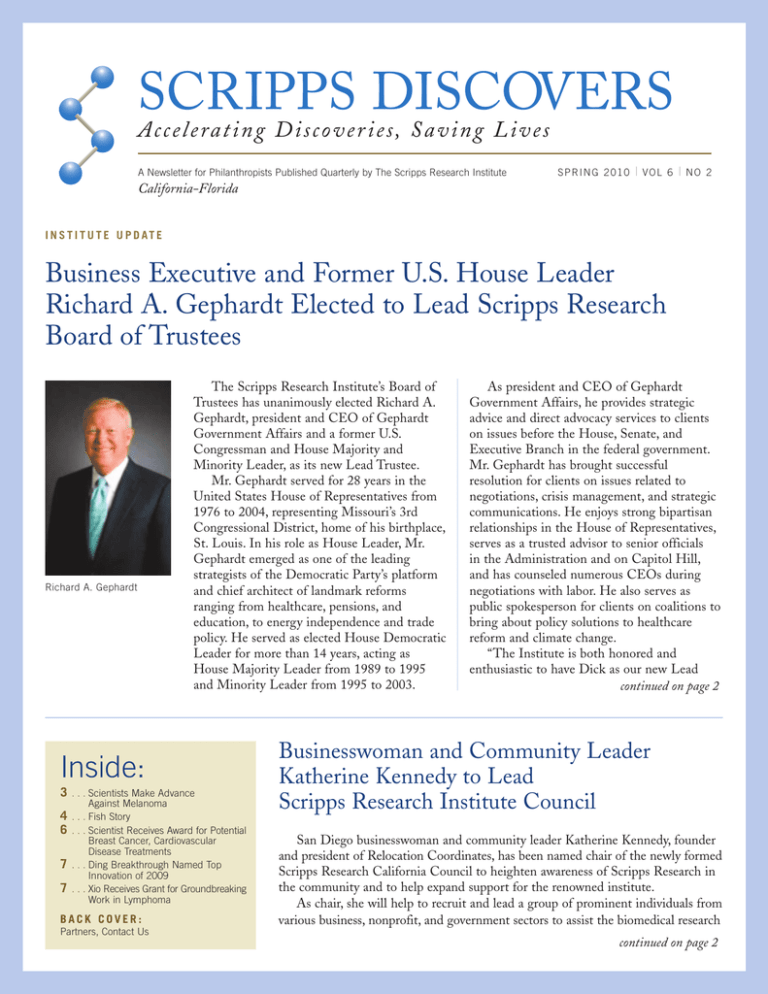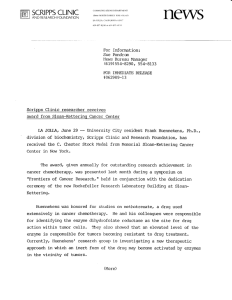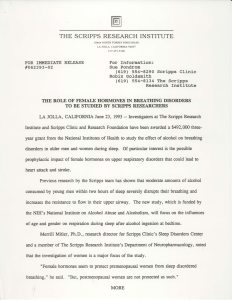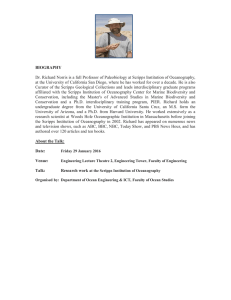SCRIPPS DISCOVERS
advertisement

SCRIPPS DISCOVERS Ac cel e ra tin g D is co ve r i es , S a v i ng L ive s A Newsletter for Philanthropists Published Quarterly by The Scripps Research Institute SPRING 2010 | VOL 6 | NO 2 California-Florida I N S T I T U T E U P D AT E Business Executive and Former U.S. House Leader Richard A. Gephardt Elected to Lead Scripps Research Board of Trustees Richard A. Gephardt The Scripps Research Institute’s Board of Trustees has unanimously elected Richard A. Gephardt, president and CEO of Gephardt Government Affairs and a former U.S. Congressman and House Majority and Minority Leader, as its new Lead Trustee. Mr. Gephardt served for 28 years in the United States House of Representatives from 1976 to 2004, representing Missouri’s 3rd Congressional District, home of his birthplace, St. Louis. In his role as House Leader, Mr. Gephardt emerged as one of the leading strategists of the Democratic Party’s platform and chief architect of landmark reforms ranging from healthcare, pensions, and education, to energy independence and trade policy. He served as elected House Democratic Leader for more than 14 years, acting as House Majority Leader from 1989 to 1995 and Minority Leader from 1995 to 2003. Inside: 3 4 6 7 7 . . . Scientists Make Advance Against Melanoma . . . Fish Story . . . Scientist Receives Award for Potential Breast Cancer, Cardiovascular Disease Treatments . . . Ding Breakthrough Named Top Innovation of 2009 . . . Xio Receives Grant for Groundbreaking Work in Lymphoma BACK COVER: As president and CEO of Gephardt Government Affairs, he provides strategic advice and direct advocacy services to clients on issues before the House, Senate, and Executive Branch in the federal government. Mr. Gephardt has brought successful resolution for clients on issues related to negotiations, crisis management, and strategic communications. He enjoys strong bipartisan relationships in the House of Representatives, serves as a trusted advisor to senior officials in the Administration and on Capitol Hill, and has counseled numerous CEOs during negotiations with labor. He also serves as public spokesperson for clients on coalitions to bring about policy solutions to healthcare reform and climate change. “The Institute is both honored and enthusiastic to have Dick as our new Lead continued on page 2 Businesswoman and Community Leader Katherine Kennedy to Lead Scripps Research Institute Council San Diego businesswoman and community leader Katherine Kennedy, founder and president of Relocation Coordinates, has been named chair of the newly formed Scripps Research California Council to heighten awareness of Scripps Research in the community and to help expand support for the renowned institute. As chair, she will help to recruit and lead a group of prominent individuals from various business, nonprofit, and government sectors to assist the biomedical research Partners, Contact Us continued on page 2 Richard A. Gephardt, CONTINUED Trustee,” said Scripps Research President Richard A. Lerner, M.D. “His immense experience as a national and international leader and his vast knowledge of the nation’s most pressing issues, coupled with his skill and energy as a business executive, will contribute invaluably to our Board.” Mr. Gephardt stated: “I am honored by this opportunity to lead the Scripps Research Institute Board of Trustees. Recognized as one of our nation's largest and well-respected, private, non-profit research institutes, Scripps Research has long played a pivotal role in ensuring America’s competitiveness globally in medical research. I look forward to working with the Board’s Katherine Kennedy, talented members to continue Scripps Research’s excellent record of contributions to medical innovation.” Widely known for his advocacy for international human rights, Mr. Gephardt currently serves as Chairman of the National Endowment for Democracy, a private, nonprofit organization that endeavors to strengthen democratic institutions around the world through nongovernmental efforts. He is a member of The Council on Foreign Relations and an Advisory Board member to the International Conservation Caucus Foundation. He also serves as Advisory Board chairman at the Richard A. Gephardt Institute for Public Service at Washington University in St. Louis. The Library and Research Center of the CONTINUED facility in La Jolla in increasing philanthropic support for its breakthrough science throughout the state and nation. “It is crucial that people from our community be introduced to the science and the innovators at The Scripps Research Institute,” Kennedy said on accepting the volunteer position. “Here, in a stunning setting, is a jewel that has long been contributing to our health and life enhancement through its discoveries. Now is the time to shine a very bright and well-deserved spotlight on The Scripps Research Institute to increase awareness, recognition, and philanthropy. She continued, “The California Council has this as its mission: drawing people to Scripps Research who, when introduced, are awed by the work and who feel compelled to promote that work to others.” “I was delighted when Katherine agreed to lead the Council,” said Scripps Research President Richard A. Lerner. “The institution will benefit greatly from her vision and leadership. Scientific research is expensive and federal funds so restrictive that we rely on philanthropy to fund our forward-looking science. Katherine will open doors, make a strong case to donors, and lend great enthusiasm and energy to our efforts.” 2 | SCRIPPS DISCOVERS Missouri History Museum in St. Louis recently opened The Richard A. Gephardt Collection to represent his life and career in Congress. Born in St. Louis, Missouri, in 1941, Mr. Gephardt earned a Bachelor of Science degree from Northwestern University in 1962 and juris doctorate from the University of Michigan Law School in 1965. He has been married to his wife, Jane, for 38 years and they have three children, Matt, Chrissy, and Kate. Mr. Gephardt, who was recently elected to the Board of Trustees, succeeds businessman and philanthropist John J. Moores, who became Lead Trustee in 2006 and who remains on the Scripps Research board. SPRING 2010 The Scripps Research California Council has been formed to attract volunteer leaders who will bring valuable networks of friends and a broad range of expertise to help Scripps Research to accelerate and enhance its results. “By serving as ambassadors and advocates for Scripps Research in various business and social communities, Katherine Kennedy Council members will extend the reach of staff and members of our Board of Trustees,” said Wendy Keeney, the institute’s vice president of philanthropy. “Central to the mission of the Council is to introduce Scripps Research to people interested in advancing biomedical research, and to get them involved in supporting the scientific efforts under way on both our California and Florida campuses.” Katherine Kennedy, a graduate of San Diego State University and former professional opera singer, is founder, president, and CEO of Relocation Coordinates, a world-class company with 27 years experience handling domestic and international relocations for corporations of all sizes. She is also co-founder and chair of Relocation Information Systems, a web-based, proprietary, customizable software application continued on page 5 R E S E A R C H U P D AT E Scientists Make Advance Against Melanoma > A team of researchers at The Scripps Research Institute and the Genomics Institute of the Novartis Research Foundation (GNF) has identified a potential new drug target for malignant melanoma, a deadly type of skin cancer that kills thousands of people in the United States every year. his new target is a protein called TYRO3, and its discovery may lead to new treatments for melanoma. In a recent issue of the journal Proceedings of the National Academy of Sciences, the scientists described how the gene works and show how blocking it affects cancer cells. “Knocking down this gene [altering it to decrease its expression] inhibits tumor formation in mice,” explains the paper’s first author Shoutian Zhu, who conducted the research with Heiko Wurdak, and their colleagues at Scripps Research and GNF. The work was led by Peter G. Schultz, who is the Scripps Family Chair Professor of Chemistry and director of GNF, and Xu Wu, adjunct assistant professor at Scripps Research and associate director of biological chemistry at GNF. T Melanoma is by far the most serious type of skin cancer, accounting for some 75 percent of all skin-cancer-related deaths. According to the National Institutes of Health, its occurrence rate has doubled in the last 30 years. When diagnosed early, melanoma is very treatable through routine surgery. Some 80 percent of people whose melanoma is detected early can be successfully treated by surgical resection. If the disease progresses undetected, however, cancerous cells can metastasize and migrate elsewhere in the body, making the disease harder to address surgically — especially since melanoma often resists standard chemotherapy treatments. The five-year survival rate for people first diagnosed with later-stage melanoma is only 16 percent. Hoping to find a new way to combat malignant melanoma, the Scripps Research and GNF team focused on a protein called MITF, which is a “master regulator” that controls many different genes necessary for melanoma cell growth and survival. MITF has been linked to melanoma in studies of cancer tissues that have shown it is often found at higher-thannormal concentrations in melanoma cells. Similar studies in other laboratories have also shown that MITF can help cancer cells to survive longer and to resist chemotherapy. However, targeting MITF itself is not feasible, due to the fact that it is a transcription factor whose function cannot easily be modulated by drugs. Aware of this problem, the scientists at Scripps Research and GNF went searching for “druggable” proteins that act as regulators of MITF itself — but only in melanoma cells. The scientists reasoned that if they could identify such a protein, they might have found a potential new way to fight the cancer. The researchers screened Professor Peter Schultz thousands of genes and identified 15 candidates that regulated MITF. When these were subjected to expression profiling among different types of cells, one gene — called TYRO3 – showed higher levels in melanoma cells. Through expression analysis of tissue samples taken from 43 patients with melanoma, the researchers found that the expression levels of TYRO3 are higher than normal skin tissues in more than half of the samples tested. That’s how the researchers identified the potential new drug target, and could then go on to design experiments to see what would happen if they reduced the levels of TYRO3 in melanoma cells. The team found that knocking down the gene’s expression inhibited the growth of cancer cells in culture dishes. They also observed that knocking down TYRO3 prevented the formation of the tumors in mice with one of the most aggressive types of melanomas. Since TYRO3 is a kinase (enzyme that regulates cell signaling) expressed on the cell surface, the next step, the researchers say, is to identify compounds or antibodies that inhibit the action of TYRO3 and to use these compounds or antibodies as starting points for designing new drugs. Different types of melanoma have different TYRO3 expression levels, and it is possible that targeting this protein would be more effective at combating some types of cancer than others. continued on page 7 SCRIPPS RESEARCH INSTITUTE | 3 SCIENTIST PROFILE Shuji Kishi: Fish Story > Shuji Kishi, an assistant professor in Scripps Florida’s Department of Metabolism and Aging, brought approximately 2,500 zebrafish with him (which he expects to eventually grow to more than 30,000 specimens) when he made the move from Harvard Medical School in the spring of last year. t Harvard, Kishi’s research was aimed at developing the zebrafish as a model for the study of aging and age-associated diseases. Zebrafish (Danio rerio) offer a number of advantages for the study of developmental biology, not to mention Kishi’s own field of aging. “Zebrafish embryos are perfect for small molecule screening for different drug targets in vivo,” he said, “and their use will help expand our overall understanding of the physiology of aging as well as early development. With them, we hope to identify compounds that will protect cells against oxidative damage, a major issue in aging and an essential risk factor of many geriatric diseases.” Over the past decade or so, zebrafish have emerged as a powerful model system to study the mechanisms underlying disease, as well as developmental dynamics – and a workable alternative to the ubiquitous mouse model. Kishi saw potential in the zebrafish back in the 1990s when he was working as a research scientist for the Japanese conglomerate JT Inc. At the time, he had just graduated from Wakayama University Medical School and was still working on his doctorate in immunology. For the company, Kishi was working on chemical compound screening for the induction or inhibition of apoptosis—programmed cell death, which has been implicated in a number of diseases, such as neurodegenerative disease and cancer. “I tried to develop zebrafish embryos for our drug screening efforts,” he said, “but unfortunately the company really wasn’t interested. That was the start of my thinking that I wanted to do different kinds of science and research than what was offered there.” So, Kishi headed to New York City. “I was interested in the research environment in the U.S.,” he said. “I think that many scientists in Japan, South Korea, and China are often eager to learn about science in the U.S. because the country has a strong history and background of doing basic research very well.” He finished his doctorate in Japan and traveled first to The Rockefeller University and then to Harvard. “It was a big gamble,” he said. “The company didn’t want me to come, so I quit my job and came anyway. I was at Rockefeller as a guest investigator, but the professor I was working with left to go back to Japan after only half a year – which I didn’t want to do. So, I applied as a postdoc with A 4 | SCRIPPS DISCOVERS SPRING 2010 another professor. He had just started his own lab at Harvard Medical School and I joined him.” It was at Harvard that Kishi got into zebrafish in a major way. Zebrafish have been called a nearly perfect model for vertebrate development because they combine the best features of all the others – they reproduce like crazy, they can be genetically manipulated to produce a wide range of mutations, and their embryos are originally transparent ex utero (as adults, they typically have stripes like a zebra, with a line that is transparent throughout life). Moreover, about 90 percent of the genome is conserved between fish and humans, so they’re remarkably similar to us except that, well, they’re fish. “Of course, they have gills instead of lungs and they have no prostate,” Kishi said, “but they basically have what we have. It might be difficult to study lung or prostate cancer but otherwise we can basically do everything else – the vasculature, the brain, even the eye structure is the same as ours.” As a result of this remarkable (and slightly creepy) similarity, a number of zebrafish mutants have been produced that are good models of human diseases, including heart disease, cancer, and Alzheimer’s – which are all related to aging. While at Harvard, Kishi worked in the Schepens Eye Research Institute but that limited his research to one particular organ. “The eye is important in aging, for example, with agerelated macular degeneration,” Kishi said. “Actually one of my fish mutants has a very similar phenotype. But my research interests are much broader, so being limited to eye research was difficult.” Those broader interests eventually led Kishi to Scripps Florida and the Department of Metabolism and Aging. He explained it this way: “I moved here because it was much better for my science. In addition, it’s better for my life. I love the warm weather and beautiful beach where we can swim almost anytime.” “Scripps Florida has the top high-throughput screening technology in the U.S.,” he continued, "plus the best chemistry department, and it’s all in one place. At Harvard there were a lot of different institutes, which had different areas of expertise but spread out, so I was always jumping around inefficiently. For instance, we did not have any high-throughput infrastructure in-house there. But here, with everything in-house, it’s easy to expand your research. Of course we don’t have fish people here. At Harvard there were a lot of fish people.” So far, Kishi is the only fish person at Scripps Research on both the Florida and California campuses, but that may change. For now, he can rely on his family for company. “Oh, yes,” he said, “my wife knows my fish. Even my kids know how to take care of the fish. They help me out with them.” In the meantime, Kishi is definitely interested in collaborative possibilities, particularly with Roy Smith, the head of his department, whose work with ghrelin, a hormone implicated in aging, dovetails with Kishi’s interests. “Roy has a very strong background in endocrinology and drug discovery, to which I would apply my fish aging models and chemical-genetic approaches,” he said. Right now, Kishi is focused on the phenomenon of neurodegeneration in zebrafish. Zebrafish have good memories—they can memorize different colors, for example —but just like people, their cognitive memory ability declines with age. This is all part of the relationship between stress and aging, Kishi said. “With our fish mutant studies, we can combine genetic Katherine Kennedy, factors and environmental factors to mimic the human condition,” he said. “We can expose them to hydrogen peroxide, gamma irradiation, UV light, and things like colder or warmer temperatures. After they are exposed to this stress, they show changes.” Kishi points out that many chronic diseases are due to multiple gene mutations and polymorphisms coupled with various environmental factors. He thinks he has a good chance of pinpointing which genes and which factors in both fish and humans—which, in turn, could lead to ways to attenuate the process. You see, fish age in three distinct ways. Rapidly, like the salmon; gradually, like zebrafish; and then, basically, not at all. The rockfish, Kishi said, can live up to 200 years. In some cases, he said, even the humble cod can live 100 years. “I have this dream that one day I can genetically engineer zebrafish to keep Assistant Professor Shuji Kishi them from growing old, like carp because zebrafish are a member of the carp family,” he said. “I don’t know how we can manipulate human beings, but if we can find ways to stay healthy until we die and prolong a healthy lifespan, those are interesting and important goals.” CONTINUED that coordinates, manages, and integrates all areas of the relocation process. A leader in her industry, she is also founder of San Diego Relocation Council, an association dedicated to educating corporations on trends in recruiting and relocation. Kennedy is a passionate advocate of organizations representing her varied interests in music, the arts, environment, politics, and of course health and science. In addition to her role as chair of the Scripps Research California Council, she is currently a member of the Board of Directors of the La Jolla Music Society, the Scripps Institute of Oceanography, and the Lincoln Club, and a member of the Strategic Advisory Board of Equinox. She is also involved in organizations including Patrons of the Prado, San Diego Rotary Club, San Diego Yacht Club, San Diego Zoological Society, Fairbanks Country Club, San Diego Social Venture Partners, Pro Kids Golf, American Red Cross, and Neighborhood House Association. She expresses one of her key beliefs this way, “Every person you know is a thread of the fabric of a community, to be woven into the most colorful and amazing cloth to support, wrap around, or overlay the needs of that community.” Kennedy is married to Robert Horsman, regional chairman of U.S. Bank. They have two very large dogs and two very large cats and reside in Point Loma. A key role of the Council will be to develop specific initiatives designed to promote Scripps Research in the philanthropic community. Other roles include hosting small events for donors and prospective donors and participating in an annual flagship event promoting the institute. The Council will also advise the administration and Trustees concerning the impact of program and policy initiatives upon operations of the California site. Those interested in knowing more about the Council’s activities may contact Wendy Keeney at (858) 784-7083 or wkeeney@scripps.edu. SCRIPPS RESEARCH INSTITUTE | 5 AWARDS AND HONORS Scripps Research Scientist Awarded More than $1.2 Million to Identify Potential Treatments for Breast Cancer and Cardiovascular Disease > Award Will Be Used to Develop High-Throughput Screening Tests at Scripps Florida he National Institutes of Health has awarded a three-year grant of more than $1.2 million to The Scripps Research Institute to develop a series of high-throughput screening tests that will help speed the discovery of potential small molecule therapies for breast cancer and cardiovascular disease. Patrick Griffin, chair of the Scripps Research Department of Molecular Therapeutics and director of the Translational Research Institute at Scripps Florida, will lead the project as principal investigator. The grant began in January. The tests will focus on identifying ligands for the orphan nuclear receptor liver receptor homolog-1 or LRH-1, which plays a crucial role in hormone-driven breast cancer through its regulation of genes involved in hormone biosynthesis as well as fat and cholesterol metabolism – key risk factors in cardiovascular disease. Receptors like LRH-1 detect circulating signaling molecules (known as ligands) such as hormones or neurotransmitters; the ligand binds to the receptor, creating a biological response or blocking the receptor. “Our goal is to uncover small molecules—either agonists or inverse agonists—that can be used to modulate or alter the activity of this important receptor,” Griffin said. “Right now, there are no potent in vivo active LRH-1 agonists and no reports of any inverse agonists. T Griffin has long maintained an interest in nuclear receptors. “There has been a lot of interest in nuclear receptors like LRH-1 and the RORs [retinoic acid receptor-related orphan receptors] because they play separate but overlapping roles in many important biological processes which make them ideal targets for the development of therapies for a wide range of disease,” Griffin said. “Even though researchers in the field have characterized all 48 known human nuclear receptors, we’re still looking for ligands for a number of them and, better still, more potent and more selective ligands. That’s what our work with LRH-1 will accomplish.” Eventually, Griffin said, the development of modulators for LRH-1 will fall under the Scripps Research Institute Molecular Screening Center (SRIMSC), part of a collaborative effort among teams of scientists at the Scripps Research California and Florida campuses, which includes Griffin as a co-principal investigator. The center employs assay development at both campuses, high-throughput robotics to screen large chemical libraries in Florida, and chemistry at both campuses to develop high quality chemical probes. The center is one of only four such large centers nationwide and was awarded more than $80 million by the National Institutes of Health in 2008 to expand its work. “Obviously, we need to better understand the function of this important receptor and its role in diseases like breast cancer if we’re going to develop new treatments. To do that, first we need to accelerate the identification of chemical probes.” The functions of agonists and antagonists are well known— a compound that activates a receptor is an agonist and one that blocks it is an antagonist. But an inverse agonist, which binds to the same site as an agonist, induces the opposite action of an agonist of that receptor. 6 | SCRIPPS DISCOVERS SPRING 2010 Professor Patrick Griffin Sheng Ding’s Stem Cell Breakthrough Named The Scientist’s Top Innovation of 2009 he stem cell work of Sheng Ding, associate professor at The Scripps Research Institute and founder of Fate Therapeutics, has been named the top innovation of 2009 by The Scientist, a magazine of the life sciences. The work, published in Cell Stem Cell in April, found a method to convert adult cells all the way back to the most primitive embryonic-like cells without using the dangerous genetic manipulations associated with previous methods. The new technique solved one of the most challenging safety hurdles associated with personalized stem cell-based medicine, enabling scientists to make stem cells in the laboratory from adult cells without genetically altering them. T Xiao Receives Recovery Act Grant for Groundbreaking Work in Lymphoma cripps Research Assistant Professor Changchun Xiao, Ph.D., was recently awarded a Challenge Grant under the American Recovery and Reinvestment Act of 2009 (Recovery Act) to discover microRNAs with diagnostic and prognostic values for diffuse B cell lymphoma, the most prevalent lymphoma type in the world. Xiao’s work was cited in a White House press release on recovery act funding for groundbreaking medical research – “Today, patients receive chemotherapy without knowledge of each individual’s sensitivity to these powerful drugs. In two years because of the recovery act, a novel approach to utilizing micro RNAs may be able to predict which patients have tumors that are likely to spread throughout the body. This information will allow physicians to identify and aggressively treat high-risk patients and spare low risk patients from ineffective treatments and their damaging side effects.” S Melanoma, CONTINUED FOR MORE INFORMATION ON MELANOMA, SEE: Even if lead drug candidates can be identified, it will likely take years to develop them into actual formulations, and their safety and effectiveness will need to be established in clinical trials before they are approved by the U.S. Food and Drug Administration. This work was supported by the Novartis Research Foundation. The National Library of Medicine www.nlm.nih.gov/medlineplus/melanoma.html The American Academy of Dermatology www.aad.org/media/background/factsheets/fact_melanoma.html SCRIPPS RESEARCH INSTITUTE | 7 Partners 1 Scripps Research continued its Frontiers in Science lecture series for donors and friends in October at the Hyatt Regency La Jolla at Aventine. At the event, Scripps Research associate professor Peter Kuhn, Ph.D. spoke to over 120 Scripps Research contributors and friends on “Novel Approaches to Monitoring the Spread of Cancer Cells – Finding the Needle in the Haystack to Develop Specialized Treatments.” Pictured at the event are Scripps Research trustee Andrew Viterbi, Ph.D., Peter Kuhn, Ph.D., and Scripps Research Chief Operating Officer Doug Bingham. (top left photo) 2 Theresa Esman recently made a major gift to support research in the laboratory of Dr. Phil LoGrasso at Scripps Florida, via the Saul and Theresa Esman Foundation. Pictured are Theresa and Phil, with Theresa holding a Scripps Florida Alborello, an historic Italian apothecary jar, which was presented to her in deepest appreciation of her gift. (top right photo) 3 The Gardens Mall at Palm Beach Gardens recently helped Scripps Florida celebrate its one year anniversary of its official opening, with a series of special events, culminating in a day of interactive science exhibits. The “CELLebrate Science” event was attended by an estimated 4,000 people. (bottom right photo) Contact Us: • For more information about Scripps Research, visit our web page at www.supportscrippsresearch.org • To learn more about supporting Scripps Research’s cutting-edge research, please contact: CALIFORNIA (858) 784.7083 or (800) 788.4931 wkeeney@scripps.edu FLORIDA (561) 228.2013 abruner@scripps.edu



